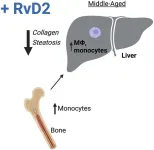Repeated blast exposures may harm the brain health of military personnel
Study shows increased brain inflammation, structural changes
2023-12-06
(Press-News.org)
The brains of special warfare community personnel repeatedly exposed to blasts show increased inflammation and structural changes compared with a control group, potentially increasing the risk of long-term, brain-related disease, according to a new study.
Researchers from the University of Virginia School of Medicine and Naval Medical Research Command (NMRC) led the study, which compared the brains of nine special operations personnel exposed to blasts with a control group of nine military service members with only minimal exposures to blasts. Participants’ brains were analyzed using sophisticated imaging techniques, combined with surveys that measured exposure to weapons and explosives as well as symptoms related to brain injury, including mood and sleep issues.
The study found that increased blast exposure was associated with increased brain inflammation, and reduced volume and thickness of brain structures. This could affect several key brain functions, including memory, motor skills and regulating emotions.
Previous studies have shown that people with many neurodegenerative conditions – including Alzheimer’s disease, Parkinson’s disease and amyotrophic lateral sclerosis (ALS) – all have chronic brain inflammation that may be detectable before the conditions fully develop.
“This is the first study to directly demonstrate increased inflammation in the brains of service members who are exposed to small blasts over a career,” said James Stone, MD, PhD, a UVA Health radiologist who led the study. “Brain inflammation is such a key process in other brain-related illnesses. These findings raise concerns about the long-term brain health of those exposed to repeated low-level blasts.”
Better Protecting Military Personnel
The next step for researchers is a larger study with more participants to determine precisely what levels of blast exposure cause brain injuries. This next study could guide military leaders in how they deploy soldiers as well as improve the design of equipment to protect against brain injuries caused by repeated blasts.
“Work is currently underway to better understand these findings and to be able to answer the question of ‘how much is too much?’ when it comes to blast overpressure exposure,” Stone said.
The study is one of several projects involving UVA Health researchers seeking to prevent brain injuries in military personnel led by Stephen Ahlers, PhD, from NMRC. UVA is part of a research team backed by an $8 million U.S. Department of Defense grant exploring the role of brain inflammation in military personnel exposed to blast shock waves.
“This research effort will enable us to understand how repetitive exposure to blast over a career is a risk factor for brain health issues, including the possibility of worsening symptoms from a traumatic brain injury unrelated to blast exposure,” according to Ahlers.
UVA researchers are also part of a group developing a model to predict how regular exposure to artillery blasts affects the brains of military personnel.
Findings Published
The researchers published their findings in the Journal of Neurotrauma. The research team consisted of Brian B. Avants, Nicholas Tustison, Jessica Gill, Elisabeth A. Wilde, Kiel D. Neumann, Leslie A. Gladney, Madison O. Kilgore, F. Bowling, Christopher M. Wilson, John F. Detro, Heather Belanger, Katryna Deary, Hans Linsenbardt, Ahlers and Stone.
This work was supported and funded by the Department of Defense Military Operational Medicine Research Program.
To keep up with the latest medical research news from UVA, subscribe to the Making of Medicine blog at http://makingofmedicine.virginia.edu.
END
[Attachments] See images for this press release:

ELSE PRESS RELEASES FROM THIS DATE:
2023-12-06
Philadelphia, December 6, 2023 – Aging is associated with chronic, nonresolving inflammation, or “inflammaging,” that can lead to tissue dysfunction. New findings reported in The American Journal of Pathology, published by Elsevier, reveal insights into the cellular programs and factors that promote the resolution of inflammation during aging. These findings may lead to the development of new strategies to limit age-related organ decline.
The resolution of inflammation is an active process that is governed by numerous factors, such as specialized ...
2023-12-06
Kirsten Bibbins-Domingo, Ph.D., M.D., M.A.S.., Editor in Chief of the Journal of the American Medical Association (JAMA) and the JAMA Network™ has been named as one of Modern Healthcare’s 100 Most Influential People in Healthcare 2023 for the second year in a row.
This program acknowledges and honors individuals who are deemed by their peers and the senior editors of Modern Healthcare to be the most influential figures in the industry in terms of leadership and impact.
"It’s an honor to be recognized for two consecutive years by Modern Healthcare," ...
2023-12-06
A new risk model uses baseline sociodemographic and financial measures to predict which patients prescribed long-term therapy with aromatase inhibitors for breast cancer are at significantly higher risk of stopping that therapy early (non-adherence).
The work will be presented in a poster spotlight discussion session at the 2023 San Antonio Breast Cancer Symposium (SABCS) on Wednesday, December 6th.
The authors analyzed data from the SWOG S1105 clinical trial, including measures of patient adherence to aromatase inhibitor (AI) therapy for hormone-sensitive breast cancer. They created a model ...
2023-12-06
To reduce marine debris, which causes serious environmental pollution in the sea, researchers at the Korea Institute of Civil Engineering and Building Technology (KICT, President Kim, Byung-suk) have developed a technology for reducing floating debris in rivers.
Since the river is the main transportation channels for land-originated marine debris, the research team led by Dr. Sang Hwa Jung launched a living lab project involving local governments, local citizens, and experts.
Chungcheongnam-do (also ...
2023-12-06
Berlin, Germany, and Washington, D.C., December 6, 2023 – Morressier, the company transforming scholarly communications, today announced the formation of a new Strategic Advisory Board composed of the most senior leaders from across the scholarly communications community. The Board, which is facilitated and supported by Morressier, will act as a lively, critical, and direct forum, stimulating innovation and collaboration across the industry on crucial issues such as research integrity and publishing workflows.
The ...
2023-12-06
In an effort to improve the health of Tribal communities and Indigenous people, the National Institutes of Health (NIH) has awarded $9 million in funding for Native scientists at Arizona State University and elsewhere to create the first Indigenous-led Tribal Data Repository.
Since the SARS-CoV-2 worldwide pandemic began, global Indigenous communities have been particularly hard hit, with health disparities including lack of access to health care and undue burden of infections leading to increased hospitalizations and higher death rates.
In response, Indigenous researchers and scientists have been working to secure and fund efforts to better understand the impact of COVID-19 and ...
2023-12-06
Detailed insights into muscle and tendon movement mechanisms during stretching are essential to improve our overall mobility and flexibility. It is not only important for optimum athletic performance, but also crucial for preventing musculoskeletal injuries. When an individual stretches, 50% to 70% of the elongation is absorbed into the muscle belly, i.e., the fleshy part of the muscle containing most fibers.
However, in skeletal muscles with fascicles, the muscle fibers are shorter than the muscle belly and attach to the tendon at an angle. This angle between the fascicles and the tendon changes in response to the length of the muscle belly ...
2023-12-06
The ocean is a critical life-support system for our planet through its role in global climate regulation. It absorbs most of the carbon emissions and heat trapped in the atmosphere which are a result of human activities. Over the years, this has led to ocean warming (OW), ocean acidification (OA), and ocean deoxygenation (OD). Moreover, increased anthropogenic‑nitrogen-deposition (AND) has largely influenced marine environments. As part of these consequences, the gases nitrous oxide (N2O) and methane (CH4) are largely controlled by 'prokaryotes’ or microbial organisms living in the ocean. While several studies have analyzed ...
2023-12-06
Research Highlights:
A study of married or partnered, middle-aged and older heterosexual couples in the U.S., England, China and India found that in 20% to 47% of the couples, both spouses/partners had high blood pressure.
The prevalence of both spouses/partners having high blood pressure was highest in England and the U.S., however, spouses/partners whose spouses/partners had high blood pressure were more likely to also have high blood pressure in China and India.
Researchers suggest couple-based interventions to improve high blood pressure diagnosis and management, such as couple-based screening, skills training or joint ...
2023-12-06
LA JOLLA (December 6, 2023)—Pancreatic cancer is one of the deadliest cancers—only about one in eight patients survives five years after diagnosis. Those dismal statistics are in part due to the thick, nearly impenetrable wall of fibrosis, or scar tissue, that surrounds most pancreatic tumors and makes it hard for drugs to access and destroy the cancer cells.
Now, researchers at the Salk Institute have discovered how a class of anti-cancer drugs called HDAC inhibitors can help treat pancreatic cancer by modulating ...
LAST 30 PRESS RELEASES:
[Press-News.org] Repeated blast exposures may harm the brain health of military personnel
Study shows increased brain inflammation, structural changes







